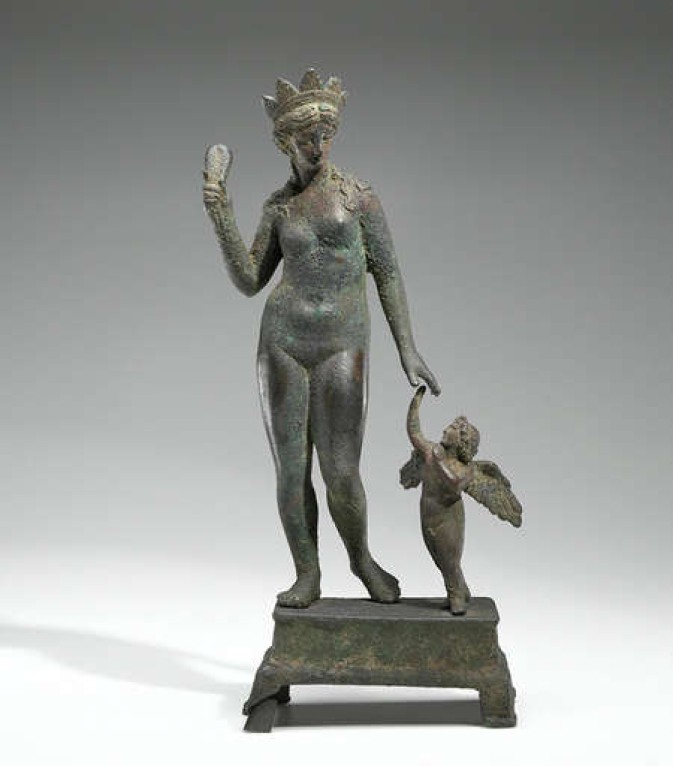Eros, the naughty superhero of love
By David Saunders
Antiquities, Collections, Exhibitions, Getty Villa, J. Paul Getty Museum
Photograph: Aphrodite Spanking Eros, Greek, 200–1 B.C. Bronze, 11 5/16 in. high. The J. Paul Getty Museum, 57.AB.7
Did you receive a Valentine’s card today? Take a second look at those cartoon Cupids. They derive, in their own way, from ancient Greece and Rome, but might not be so cute as they first appear.
Eros Wearing a Lionskin, Greek, 100–1 B.C. Terracotta, pigment, and gold, 15 3/4 in. high. The Museum of Fine Arts, Boston. Henry Lillie Pierce Fund
Then as now, Cupid’s presence denotes passion and desire, and our word “erotic” comes from Eros, his Greek name. Depictions of this youthful winged god, often shown with his bow and arrow, abound in ancient art. A fabulous example is this terracotta statue in the collection of the Museum of Fine Arts, Boston, which will feature in our upcoming exhibition at the Getty Villa, Aphrodite and the Gods of Love (currently on display in Boston until February 20th).
Standing 40 centimeters high and dating to the late first century B.C., this is a terracotta masterpiece. The slight lean in his hips, the right arm behind his back, that sweet—or is it sarcastic?—smile, all convey the cocky swagger of the chubby boy-god.
Tied around Eros’s chest, and secured with a little medallion, are the paws of the furry lionskin that covers his head and shoulders and falls to the ground behind his back. Why should Eros be wearing a lionskin? It immediately puts us in mind of that other famous lionskin wearer, the Greek hero Herakles, who overcame his opponents with his enormous strength.
How endearing, we might think, for the little god to be dressed up as the mightiest figure of Greek myth. But there may be more to it than that. The lionskin equates Herakles and Eros, suggesting that love is as mighty as the all-conquering superhero. Few would dispute that. But Eros is a child, and can hardly be counted upon to use his strength responsibly. Indeed, he often toys with his victims without concern for the consequences.
This is not merely the opinion of a curator whose mailbox has been repeatedly empty on Valentine’s Days gone by. Far from it—Eros’s capricious ways were a recurring grounds for complaint in antiquity. Take, for example, the Greek poet Anakreon, writing in the sixth century B.C.:
Like a blacksmith with his huge hammer, Eros has knocked me again and doused me in a wintry ditch.
Or for a female perspective, listen to the complaint of the besotted Phaedra in the first (and only partially surviving) version of Euripides’ play Hippolytos:
I have a teacher of daring and audacity, who is most inventive amid difficulties. Eros, the hardest god of all to fight.
The full scale of Eros’s power is expressed by the Chorus in the second version of the same play:
Winged and gold-gleaming, Eros flies over the earth and the loud-roaring salt sea. He bewitches the one upon whose love-maddened heart he flies. He bewitches the whelps of the mountain and those of the sea, what the earth brings forth and what the blazing sun looks down upon, and likewise mortal men…
It’s not surprising, therefore, that even Aphrodite found him a handful. In the story of Jason’s quest for the Golden Fleece, the gods plan for the princess Medea to fall in love with the hero and help him. Hera and Athena go to visit Aphrodite, to ask her to persuade her son to assist. Yet when the topic of Eros is raised, Aphrodite’s first response is:
Hera and Athena, he would obey you much more than me, for impudent as he is, he will have at least a little respect in his eyes for you—whereas he pays no attention to me and incessantly picks a quarrel and belittles me….
Aphrodite’s frustrations are well conveyed by a bronze statuette in the Getty’s collection (J. Paul Getty bought a number of statues of the goddess). The goddess brandishes a slipper or a roll of fabric in her right hand, and is about to spank her miscreant son.
Aphrodite Spanking Eros, Greek, 200–1 B.C. Bronze, 11 5/16 in. high. The J. Paul Getty Museum, 57.AB.7
Eros’s capacity for causing trouble will be one of the themes in our upcoming exhibition Aphrodite and the Gods of Love, which highlights the manipulative and sometimes destructive characteristics of Aphrodite and Eros. Featuring over one hundred objects from the collections of the Museum of Fine Arts, Boston, and the Getty (including the two discussed here) together with a selection of spectacular loans from Italy, the show opens on March 28th, and I look forward to welcoming you to it. In the meantime, though, I hope Eros treats you kindly.
The show continues until July 9th, 2012.
Following its showing at the Getty, the exhibition will be on view at the San Antonio Museum of Art from September 15, 2012 to February 17, 2013 and at the Philbrook Museum of Art in Tulsa from March 10 to May 26, 2013.
Don't miss it!
